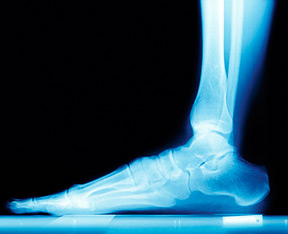Healthy From the Ground Up
By Kevin M. Wong, DC
It has been my experience that more than any other part of the body, the feet are overlooked on a regular basis. That's a shame because the feet are the foundation of the body. If your feet aren't functioning properly, the rest of your body will eventually be affected.
It's important to understand why and how this happens. Any structural imbalance requires compensating movements in the lower extremities and pelvis in order to minimize as much as possible stresses and strains that would affect the spinal column. Over time, however, specific muscle imbalances and shortenings will develop. Eventually, the soft tissues and bones will be damaged by microtrauma, which can eventually lead to pain and discomfort.
Foot Problems Arch Issues
The foot has three arches (medial longitudinal, lateral longitudinal, and transverse or metatarsal) which are supposed to be working together to support the 26 bones of each foot. The stability of the tibia, fibula, femur, hips, pelvis and spine are all dependent on these three foot arches. Well-supported arches mean that biomechanics are healthy and stress is reduced throughout the axial kinematic chain going from the feet all the way up to the head.
When one or more of the arches aren't working, we start to see problems. Arches that are unsupported or supported improperly will generally result in one of two outcomes: overpronation or oversupination. Classic supinators tend to put tremendous pressure on the lateral longitudinal and transverse arches of their feet. These are the people who truly do have a high instep or a high medial longitudinal arch when weight-bearing. As interesting as it is to find someone like this, don't expect to find them that often. I find that only 3-5 percent of my patient population is true supinators.
 It is more common to find excessive pronators. These patients have the collapse of all three of the arches; their feet are often wider and longer as a result. I find the prevalence of these types of patients is in the 80-90 percent range.
It is more common to find excessive pronators. These patients have the collapse of all three of the arches; their feet are often wider and longer as a result. I find the prevalence of these types of patients is in the 80-90 percent range.
When the arches of the feet fall or flatten into excessive foot pronation, the foot physically drops downward toward the floor. As the foot drops, the ankle becomes stressed in the medial portion. This creates excessive medial rotation of the tibia and femur. This inward rotation of the leg bones creates a lateral pulling on the greater trochanter of the femur as well. Following the chain of events upward, the pelvis torques backward, which creates stress to the lumbar (lower) spine and upward to the thoracic (mid-spine), cervical (upper spine / neck) and skull areas.
Quite often, you might not have any pain in your feet at all. The pain may actually be higher up in the kinematic chain. It might only be knee pain, hip pain or back pain. The key is to realize that the feet are the gateways to the rest of the body. A lack of support in one or both feet will have negative effects on the body over time.
Addressing Arch Problems: What Your Chiropractor Can Do
Stabilizing orthotics: I always recommend custom-made, stabilizing orthotics (shoe inserts) because they help promote healthy biomechanics, neurology and circulation for the feet. I often have patients bring in old orthotics they have or are currently wearing so I can check them and see how they are working. A good pair of stabilizing orthotics will change people's lives by allowing them to do activities they enjoy and enhancing their quality of life.
Foot exercises:
Rolling exercises: Using a foot roller, tennis ball, golf ball or firm rubber ball, stand and put pressure under the various parts of the foot. This helps stretch the tight plantar fascia and intrinsic foot muscles.
Calf stretch: Place your forefoot on a step and gently lower the heel until you feel a gentle pull in the calf. Do not apply too much body-weight; it should be very gradual and comfortable.
Towel scrunch: Throw a towel on the floor. Grasp or bunch the towel under the feet by scrunching or flexing the toes. This actually helps with forefoot range of motion as well as strengthening of the intrinsic foot muscles.
Tubing exercises: Wrap surgical tubing or elastic bands around the forefoot and perform dorsiflexion, plantarflexion, inversion and eversion exercises (ask your chiropractor for specific exercises and the proper tubing / bands to use). I have my patients do these exercises for one minute in each direction, two times per day. I have them vary the speeds from slow during the first week or two and then faster by the third week. The exercises are quick and easy.
Supportive shoes. Many people tend to overlook footwear, even though it can have a significant impact on their feet. I suggest that the next time you're at your chiropractor's office, remove your shoes so they can examine them. Your chiropractor will likely bend each shoe in various directions and see how supportive it is.
Remember, your feet affect your entire foundation and therefore your entire kinetic chain from the ground up. Being properly supported can help not only your feet, but also your knees, hips, back and neck. Talk to your doctor of chiropractic for more information.
Kevin M. Wong, DC, a 1996 graduate of Palmer College of Chiropractic West in San Jose, Calif., practices full-time in Orinda, Calif. He is also an instructor for Foot Levelers, Inc.

